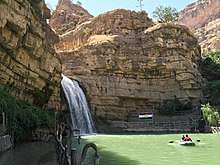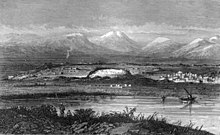Persecution of Yazidis by Kurds
The Persecution of Yazidis by Kurds describes mainly the massacres of the Yazidis committed by some Muslim Kurdish tribes. Sometimes, during these massacres, the Muslim Kurds tried to force the Yazidis to convert to Islam.[1][2] Almost the whole Yazidi population were nearly wiped out by massacres carried out by the Turks and Kurds in the 19th century.[3][4] While modern persecution describes a takeover of Yazidi settlement areas with simultaneous assimilation of the Yazidis by the Kurdistan Region.[5][6]

History
Historically, there were many massacres of Yazidis committed by Kurds. In the 10th century the Kurds started persecuting the Yazidis in the Hakkari mountains.[8] The Kurds persecuted the Yazidis with particular brutality.[9] In the year 1832, about 70,000 Yazidis were killed by the Kurdish leaders Bedir Khan Beg and Mohammed Pasha Rawanduz.[10] During his research trips in 1843, the Russian traveller and orientalist Ilya Berezin mentioned that 7,000 Yazidis were killed by Kurds on the hills of Nineveh near Mosul, shortly before his arrival.[11]
In 1414, the Kurds killed the Yazidis in the mountains of Hakkari.[12] Then the Kurds destroyed the holy temple Lalish of the Yazidis and desecrated the tomb of Sheikh Adi. Later, the Yazidis rebuilt their temple and the tomb of Sheikh Adi.[13]
In 1831, the Kurdish emir Mohammed Pasha Rawanduz (Mire Kor, the blind prince) moved with his army to the village of Kellek and had putting the inhabitants of this Yazidi village to the sword. Then he went northward and attacked the entire Yazidi-inhabited foothill country east of Mosul. Thousands of Yazidi men, women and children were killed by his army. Some Yazidis managed to take refuge in the neighboring forests and mountain fastnesses, and a few managed to escape to distant places.[14]

In 1832, the Kurdish emir Mohammed Pasha Rawanduz with his troops committed a massacre on the Yazidis in Khatarah. Subsequently, the Kurds attacked the Yazidis in Shekhan and killed many of them.[16] In another attempt he and his troops occupied over 300 Yazidi villages. The Kurds kidnapped over 10,000 Yazidis to Rawandiz. Then they gave them the option to convert to Islam or to be killed. Most of them converted to Islam and the rest who refused were killed.[17]
In 1832, the Kurdish emir Bedir Khan Beg (Mire Botan, the prince of Bohtan) with his troops committed a massacre on the Yazidis in Shekhan. The Kurds have killed almost the whole Yazidi population of Shekhan. Some Yazidis tried to escape to Sinjar.[18][19] By the attempt to escape to Sinjar, many Yazidis have going into the Tigris river. Those Yazidis who could not swim were killed by the Kurds. About 12,000 Yazidis were killed on the bank of the Tigris river by the Kurds. Kurds also kidnapped many Yazidi women and children.[20]
In 1833, the Yazidis were attacked in the Aqrah region again by the Kurdish emir Mohammed Pasha Rawanduz and his soldiers. The Kurds killed 500 Yazidis in the upper Zab. After that, the Kurds attacked the Yazidis in Sinjar and killed many of them.[21]
In 1844, the Kurdish emir Bedir Khan Beg committed a repeated massacre on the Yazidis in the Tur Abdin region. Many Yazidis were killed by the Kurds. The Kurds have also captured many Yazidis to force them to convert to Islam. Seven Yazidi villages have been forced to Islam and have converted.[20]
In 1915–1923, Yazidis were killed alongside Armenians during the Armenian genocide at the hands of the Kurds. More than 300,000 Yazidis were killed. Many Yazidis have also fled to Transcaucasia.[22][23]
Modern times
Since 2003, when the Kurds occupied the settlements of the Yazidis in the disputed territories of Northern Iraq, the Yazidis were undergoing a process of Kurdification by the Kurdistan Regional Government (KRG).[5][6] According to a report by Human Rights Watch, the Kurdish authorities have used heavy-handed tactics against the Yazidis and some Yazidis were kidnapped and beaten by the KRG.[24]
There have also been some demographic changes in Yazidi-majority areas after the fall of Saddam. In the Sheikhan area, which is considered a historic Yazidi stronghold, the Kurdish authorities have settled Sunni Kurds to strengthen their claim that it should be a Kurdish area.[5]
Resistance of the Yazidis
Some years ago, the Yazidis were a very powerful tribe.[15] The most powerful tribe of the Yazidis inhabits the mountain of Sinjar.[25]

Many Yazidis also defended themselves against the Kurdish attacks. So did Ali Beg, the Yazidi leader in Sheikhan. Yazidi leader Ali Beg used his forces to oppose Kurdish leader Mohammed Pasha Rawanduz, who mobilized the Kurdish tribes of the surrounding mountains to attack the Yazidis. Ali Beg's troops were outnumbered and Ali Beg was captured and killed by the Bey of Rawandiz.[15]
Kurdish view
The relations between the Yazidis and the Kurds were often tense.[26] Most Kurds view the Yazidis as so-called "unbelievers".[27][28] In the past, this view of the Kurds often led to massacres and forced conversions on the Yazidis.
Kurdish muftis have given the persecution of Yazidis by Kurds a religious character and legalized it.[14] Also Kurdish mullahs such as Mahmud Bayazidi viewed the Yazidis as unbelievers.[9]
See also
References
- Orient-Institut, Deutsches; Franz, Erhard (1994). Population policy in Turkey: family planning and migration between 1960 and 1992. Deutsches Orient-Institut. p. 332.
Throughout history, there was no shortage of attempts by Kurdish Muslims to violently convert the Yazidis to Islam.
- Non-State Violent Actors and Social Movement Organizations: Influence, Adaptation, and Change. Emerald Group Publishing. 2017-04-26. p. 75. ISBN 9781787147287.
- Travis, Hannibal (2010). Genocide in the Middle East: The Ottoman Empire, Iraq, and Sudan. Carolina Academic Press. ISBN 9781594604362.
The Yazidis were nearly wiped out by massacres carried out by Turks and Kurds.
- Ghareeb, Edmund A.; Dougherty, Beth (2004-03-18). Historical Dictionary of Iraq. Scarecrow Press. p. 248. ISBN 9780810865686.
Massacres at the hands of the Ottoman Turks and Kurdish princes almost wiped out the Yazidis during the 19th century.
- Documentation, Austrian Centre for Country of Origin and Asylum Research and (2017-10-02). "Anfragebeantwortung zum Irak: Lage der JesidInnen, insbesondere in der Provinz Ninawa [a-10353]". www.ecoi.net (in German). Retrieved 2019-06-19.
- Shanks, Kelsey (2015-11-19). Education and Ethno-Politics: Defending Identity in Iraq. Routledge. ISBN 9781317520429.
- "Explainer: Who are the Yazidis?". SBS News.
- Naby, Eden (2009). "Yazīdīs". In Esposito, John (ed.). The Oxford Encyclopedia of the Islamic World. Oxford University Press. ISBN 9780195305135.
- Asatrian, Garnik S.; Arakelova, Victoria (2014-09-03). The Religion of the Peacock Angel: The Yezidis and Their Spirit World. Routledge. ISBN 9781317544289.
- Steinvorth, Daniel (2016-12-22). "Jagd auf den Engel Pfau | NZZ" (in German). ISSN 0376-6829. Retrieved 2019-09-30.
- Field, Henry (1951). "Appendix A: A visit to the Yezidis in 1843 by Ilya Berezin, in The Anthropology of Iraq". iiif.lib.harvard.edu. p. 76. Retrieved 2019-09-30.
- Acikyildiz, Birgul (2014-08-20). The Yezidis: The History of a Community, Culture and Religion. I.B.Tauris. ISBN 9781784532161.
- "Die Religionsgemeinschaft der Yezidi: Weh dem, der nicht ans Höllenfeuer glaubt - Qantara.de". Qantara.de - Dialog mit der islamischen Welt (in German).
- Jwaideh, Wadie (2006-06-19). The Kurdish National Movement: Its Origins and Development. Syracuse University Press. ISBN 978-0-8156-3093-7.
- Layard, Austen Henry (1849). Niniveh and Its Remains: With an Account of a Visit to the Chaldaean Christians of Kurdistan, and the Yezidis, Or Devil-Worshippers : and an Enquiry Into the Manners and Arts of the Ancient Assyrians. Murray.
- Jwaideh, Wadie (2006). The Kurdish National Movement: Its Origins and Development. Syracuse University Press. ISBN 9780815630937.
- NEBEZ, Jemal (2017-08-14). Der kurdische Fürst MĪR MUHAMMAD AL-RAWĀNDIZĪ genannt MĪR-Ī KŌRA: Ein Beitrag zur kurdischen Geschichte (in German). epubli. ISBN 9783745011258.
- Barbara Henning (2018). Narratives of the History of the Ottoman-Kurdish Bedirhani Family. p. 99. ISBN 3863095510.
- Acikyildiz, Birgul (2014-08-20). The Yezidis: The History of a Community, Culture and Religion. I.B.Tauris. ISBN 9781784532161.
- Tagay, Sefik; Ortac, Serhat. "Die Eziden und das Ezidentum – Geschichte und Gegenwart einer vom Untergang bedrohten Religion" (PDF) (in German). pp. 49–50.
- Ateş, Sabri (2013-10-21). Ottoman-Iranian Borderlands: Making a Boundary, 1843-1914. Cambridge University Press. ISBN 9781107033658.
- Maisel, Sebastian (2018-06-30). The Kurds: An Encyclopedia of Life, Culture, and Society. ABC-CLIO. ISBN 9781440842573.
- Rezvani, Babak (2014-03-15). Ethno-territorial conflict and coexistence in the caucasus, Central Asia and Fereydan: academisch proefschrift. Amsterdam University Press. ISBN 9789048519286.
- "On Vulnerable Ground | Violence against Minority Communities in Nineveh Province's Disputed Territories". Human Rights Watch. 2009-11-10.
In one incident, Kurdish intelligence officers arrested two Yazidi activists, Khalil Rashu Alias and Wageed Mendo Hamoo, in May 2007. The two told Human Rights Watch that Kurdish authorities imprisoned the pair for almost six months and tortured them for resisting what they called the Kurdish colonization of their territory in Sinjar.
- The Classical Journal. A. J. Valpay. 1813.
- The Churchman's Monthly Magazine. C. Shepard & Company. 1855.
- Prichard, James Cowles (1845). Naturgeschichte des Menschengeschlechts; nach der 3. Aufl. mit Anmerkungen und Zusätzen hrsg. von Rudolph Wagner (in German). Voß.
- Jödicke, Ansgar (2017-08-04). Religion and Soft Power in the South Caucasus. Routledge. ISBN 978-1-351-79789-4.